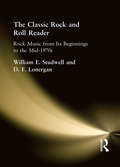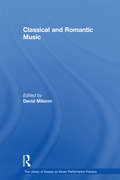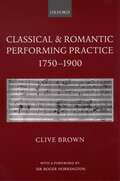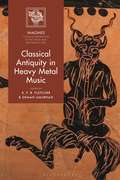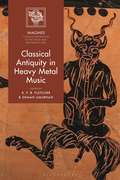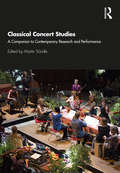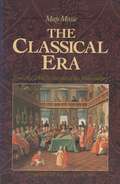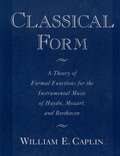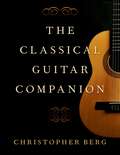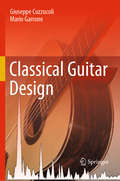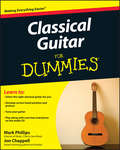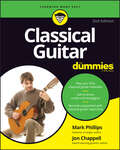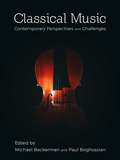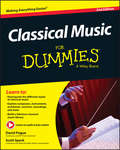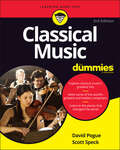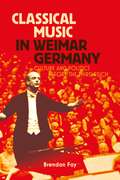- Table View
- List View
The Classic Rock and Roll Reader: Rock Music from Its Beginnings to the Mid-1970s
by William E Studwell David LonerganThe Classic Rock and Roll Reader: Rock Music from Its Beginnings to the Mid-1970s is chock full of entertaining essays to inform and delight you about an era that shaped our culture and future musical trends. This unique book will surprise and enchant even the most zealous music buff with facts and information on the songs that reflected America’s spirit and captured a nation&’s attention. The Classic Rock and Roll Reader is offbeat, somewhat irreverent, ironic, and ancedotal as it discusses hundreds of rock and non-rock compositions included in rock history era. The songs offer you information on: Rock’s Not So Dull Predecessors (for example, “Bewitched, Bothered, and Bewildered” and “The Cry of the Wild Goose”) The Pioneering Rock Songs (such as “Rock Around the Clock” and “Shake, Rattle, and Roll” ) Older Style Songs Amidst the Rocks (for example, “I Could Have Danced All Night” and “Rocky Mountain High” ) The Megastars and Megagroups (such as “Blue Suede Shoes,” “Respect,” and “Surfin’USA” ) The Best Songs that Never Made No. 1 (for example,“ I Feel Good” and “ Tie a Yellow Ribbon Round the Ole Oak Tree” )The Classic Rock and Roll Reader: Rock Music from Its Beginnings to the Mid-1970s also examines the music which preceded early rock, the music which followed early rock, and the numerous non-rock songs which flourished during the classic rock period. A wide spectrum of music is discussed in well over 100 essays on various songs. Musicians, librarians, and the general audience will be taken back to the birth of rock and roll and the various contributing influences. Analyzing each song’s place in rock history and giving some background about the artists, The Classic Rock and Roll Reader offers even the most avid music enthusiast new and unique information in this thorough and interesting guide.
The Classic Rock and Roll Reader: Rock Music from Its Beginnings to the Mid-1970s
by William E Studwell David LonerganThe Classic Rock and Roll Reader: Rock Music from Its Beginnings to the Mid-1970s is chock full of entertaining essays to inform and delight you about an era that shaped our culture and future musical trends. This unique book will surprise and enchant even the most zealous music buff with facts and information on the songs that reflected America’s spirit and captured a nation&’s attention. The Classic Rock and Roll Reader is offbeat, somewhat irreverent, ironic, and ancedotal as it discusses hundreds of rock and non-rock compositions included in rock history era. The songs offer you information on: Rock’s Not So Dull Predecessors (for example, “Bewitched, Bothered, and Bewildered” and “The Cry of the Wild Goose”) The Pioneering Rock Songs (such as “Rock Around the Clock” and “Shake, Rattle, and Roll” ) Older Style Songs Amidst the Rocks (for example, “I Could Have Danced All Night” and “Rocky Mountain High” ) The Megastars and Megagroups (such as “Blue Suede Shoes,” “Respect,” and “Surfin’USA” ) The Best Songs that Never Made No. 1 (for example,“ I Feel Good” and “ Tie a Yellow Ribbon Round the Ole Oak Tree” )The Classic Rock and Roll Reader: Rock Music from Its Beginnings to the Mid-1970s also examines the music which preceded early rock, the music which followed early rock, and the numerous non-rock songs which flourished during the classic rock period. A wide spectrum of music is discussed in well over 100 essays on various songs. Musicians, librarians, and the general audience will be taken back to the birth of rock and roll and the various contributing influences. Analyzing each song’s place in rock history and giving some background about the artists, The Classic Rock and Roll Reader offers even the most avid music enthusiast new and unique information in this thorough and interesting guide.
Classical and Romantic Music
by David MilsomThis volume brings together twenty-two of the most diverse and stimulating journal articles on classical and romantic performing practice, representing a rich vein of enquiry into epochs of music still very much at the forefront of current concert repertoire. In so doing, it provides a wide range of subject-based scholarship. It also reveals a fascinating window upon the historical performance debate of the last few decades in music where such matters still stimulate controversy.
Classical and Romantic Music
by David MilsomThis volume brings together twenty-two of the most diverse and stimulating journal articles on classical and romantic performing practice, representing a rich vein of enquiry into epochs of music still very much at the forefront of current concert repertoire. In so doing, it provides a wide range of subject-based scholarship. It also reveals a fascinating window upon the historical performance debate of the last few decades in music where such matters still stimulate controversy.
Classical and Romantic Performing Practice 1750-1900
by Clive BrownThe past ten years have seen a rapidly growing interest in performing and recording Classical and Romantic music with period instruments; yet the relationship of composers' notation to performing practices during that period has received only sporadic attention from scholars, and many aspects of composers' intentions have remained uncertain. Brown here identifies areas in which musical notation conveyed rather different messages to the musicians for whom it was written than it does to modern performers, and seeks to look beyond the notation to understand how composers might have expected to hear their music realized in performance. There is ample evidence to demonstrate that, in many respects, the sound worlds in which Mozart, Beethoven, Wagner, and Brahms created their music were more radically different from ours than is generally assumed.
Classical Antiquity in Heavy Metal Music (IMAGINES – Classical Receptions in the Visual and Performing Arts)
by K. F. B. Fletcher Osman UmurhanThis book demonstrates the rich and varied ways in which heavy metal music draws on the ancient Greek and Roman world. Bands from across the globe, including Italy's Stormlord and Heimdall, Greece's Kawir, Switzerland's Eluveitie and Celtic Frost, Norway's Theatre of Tragedy, Sweden's Therion, Germany's Blind Guardian, Canada's Ex Deo and the UK's Iron Maiden and Bal-Sagoth, are all discussed in this volume. These and other bands are shown to draw inspiration from classical literature and mythology such as Homer's Iliad, Virgil's Aeneid and Caesar's Gallic Wars and from historical peoples such as the Scythians, ancient Egyptians and Roman emperors. These interactions are often concerned with the nature of paganism, the occult and barbarism, nationalism, the conflict between East and West, and the development of powerful evocations of brutality and femininity. The contributors frequently weave in comparisons with the reception of antiquity in painting and literature to show how the genre of heavy metal brings its own perspectives to classical reception but also shows strands of continuity of practice. They show how this musical genre – often dismissed as lowbrow – engages in sophisticated dialogue with ancient texts, myths, and historical figures, revealing aspects of Classics' continued appeal while also arguing that the engagement with myth and history is a defining characteristic of heavy metal music, especially in countries that were once part of the Roman Empire.
Classical Antiquity in Heavy Metal Music (IMAGINES – Classical Receptions in the Visual and Performing Arts)
This book demonstrates the rich and varied ways in which heavy metal music draws on the ancient Greek and Roman world. Bands from across the globe, including Italy's Stormlord and Heimdall, Greece's Kawir, Switzerland's Eluveitie and Celtic Frost, Norway's Theatre of Tragedy, Sweden's Therion, Germany's Blind Guardian, Canada's Ex Deo and the UK's Iron Maiden and Bal-Sagoth, are all discussed in this volume. These and other bands are shown to draw inspiration from classical literature and mythology such as Homer's Iliad, Virgil's Aeneid and Caesar's Gallic Wars and from historical peoples such as the Scythians, ancient Egyptians and Roman emperors. These interactions are often concerned with the nature of paganism, the occult and barbarism, nationalism, the conflict between East and West, and the development of powerful evocations of brutality and femininity. The contributors frequently weave in comparisons with the reception of antiquity in painting and literature to show how the genre of heavy metal brings its own perspectives to classical reception but also shows strands of continuity of practice. They show how this musical genre – often dismissed as lowbrow – engages in sophisticated dialogue with ancient texts, myths, and historical figures, revealing aspects of Classics' continued appeal while also arguing that the engagement with myth and history is a defining characteristic of heavy metal music, especially in countries that were once part of the Roman Empire.
Classical Concert Studies: A Companion to Contemporary Research and Performance
by Martin TröndleClassical Concert Studies: A Companion to Contemporary Research and Performance is a landmark publication that maps out a new interdisciplinary field of Concert Studies, offering fresh ways of understanding the classical music concert in the twenty-first century. It brings together essays, research articles, and case studies from scholars and music professionals including musicians, music managers, and concert designers. Gathering both historical and contemporary cases, the contributors draw on approaches from sociology, ethnology, musicology, cultural studies, and other disciplines to create a rich portrait of the classical concert’s past, present, and future.Based on two earlier volumes published in German under the title Das Konzert (The Concert), and with a selection of new chapters written for the English edition, this companion enables students, researchers, and practitioners in the classical and contemporary music fields to understand this emerging field of research, go beyond traditional disciplinary boundaries and methodologies, and spark a renaissance for the classical concert.
Classical Concert Studies: A Companion to Contemporary Research and Performance
by Martin Tröndle Erik DorsetClassical Concert Studies: A Companion to Contemporary Research and Performance is a landmark publication that maps out a new interdisciplinary field of Concert Studies, offering fresh ways of understanding the classical music concert in the twenty-first century. It brings together essays, research articles, and case studies from scholars and music professionals including musicians, music managers, and concert designers. Gathering both historical and contemporary cases, the contributors draw on approaches from sociology, ethnology, musicology, cultural studies, and other disciplines to create a rich portrait of the classical concert’s past, present, and future.Based on two earlier volumes published in German under the title Das Konzert (The Concert), and with a selection of new chapters written for the English edition, this companion enables students, researchers, and practitioners in the classical and contemporary music fields to understand this emerging field of research, go beyond traditional disciplinary boundaries and methodologies, and spark a renaissance for the classical concert.
The Classical Era: Volume 5: From the 1740s to the end of the 18th Century (Man & Music)
by Professor Neal ZaslawFrom the series examining the development of music in specific places during particular times, this book looks at the classical period, in Europe and America, from Vienna and Salzburg to the Iberian courts and Philadelphia.
Classical Form: A Theory of Formal Functions for the Instrumental Music of Haydn, Mozart, and Beethoven
by William E. CaplinBuilding on ideas first advanced by Arnold Schoenberg and later developed by Erwin Ratz, this book introduces a new theory of form for instrumental music in the classical style. The theory provides a broad set of principles and a comprehensive methodology for the analysis of classical form, from individual ideas, phrases, and themes to the large-scale organization of complete movements. It emphasizes the notion of formal function, that is, the specific role a given formal unit plays in the structural organization of a classical work.
Classical Form: A Theory of Formal Functions for the Instrumental Music of Haydn, Mozart, and Beethoven
by William E. CaplinBuilding on ideas first advanced by Arnold Schoenberg and later developed by Erwin Ratz, this book introduces a new theory of form for instrumental music in the classical style. The theory provides a broad set of principles and a comprehensive methodology for the analysis of classical form, from individual ideas, phrases, and themes to the large-scale organization of complete movements. It emphasizes the notion of formal function, that is, the specific role a given formal unit plays in the structural organization of a classical work.
The Classical Guitar Companion
by Christopher BergThe Classical Guitar Companion is an anthology of guitar exercises, etudes, and pieces organized according to technique or musical texture. Expert author Christopher Berg, a veteran guitar instructor, bring together perspectives as an active performing artist and as a teacher who has trained hundreds of guitarists to encourages students to work based on their own strengths and weaknesses. The book opens with "Learning the Fingerboard", a large section devoted to establishing a thorough knowledge of the guitar fingerboard through a systematic and rigorous study of scales and fingerboard harmony, which will lead to ease and fluency in sight-reading and will reduce the time needed to learn a repertoire piece. The following sections "Scales and Scale Studies", "Repeated Notes", "Slurs", "Harmony", "Arpeggios", "Melody with Accompaniment", "Counterpoint" and "Florid or Virtuoso Studies" each contain text and examples that connect material to fingering practices of composers and practice strategies to open a path to interpretive freedom in performance. The Classical Guitar Companion will serve as a helpful companion for many years of guitar study.
The Classical Guitar Companion
by Christopher BergThe Classical Guitar Companion is an anthology of guitar exercises, etudes, and pieces organized according to technique or musical texture. Expert author Christopher Berg, a veteran guitar instructor, bring together perspectives as an active performing artist and as a teacher who has trained hundreds of guitarists to encourages students to work based on their own strengths and weaknesses. The book opens with "Learning the Fingerboard", a large section devoted to establishing a thorough knowledge of the guitar fingerboard through a systematic and rigorous study of scales and fingerboard harmony, which will lead to ease and fluency in sight-reading and will reduce the time needed to learn a repertoire piece. The following sections "Scales and Scale Studies", "Repeated Notes", "Slurs", "Harmony", "Arpeggios", "Melody with Accompaniment", "Counterpoint" and "Florid or Virtuoso Studies" each contain text and examples that connect material to fingering practices of composers and practice strategies to open a path to interpretive freedom in performance. The Classical Guitar Companion will serve as a helpful companion for many years of guitar study.
Classical Guitar Design
by Giuseppe Cuzzucoli Mario GarroneThis book describes the entire process of designing guitars, including the theory and guidelines for implementing it in practice. It discusses areas from acoustics and resonators to new tools and how they assist traditional construction techniques. The book begins by discussing the fundamentals of the sounds of a guitar, strings, and oscillating systems. It then moves on to resonators and acoustics within the guitar, explaining the analysis systems and evaluation methods, and comparing classic and modern techniques. Each area of the guitar is covered, from the soundboard and the back, to the process of closing the instrument. The book concludes with an analysis of historic and modern guitars. This book is of interest to luthiers wanting to advance their practice, guitar players wishing to learn more about their instruments, and academics in engineering and physics curious about the principles of acoustics when applied to musical instruments.
Classical Guitar For Dummies
by Jon Chappell Mark PhillipsLearn to: Select the right classical guitar for you Develop correct hand position and posture Tune your guitar Play along with exercises and pieces on the audio CD The fun and easy way® to start playing classical guitar! Want to be a classical guitarist, but never had a lesson? No problem — this hands-on guide teaches you all the fundamental techniques you need to play scales, melodies, and full-length pieces in the classical style. You get plenty of practice exercises to stretch your skills, selections from the classical repertoire, and a bonus audio CD that helps you play along with the music pieces from the book! Get acquainted with your guitar — familiarize yourself with the unique make-up and parts of a classical guitar Start making some music — play melodies on individual strings, move on to arpeggios, and get your fingers in shape with scales Ramp up your technique — play barres, slurs, and trills; handle harmonics; master right-hand tremolo; and venture up the neck to play in the higher positions Build your classical repertoire — from Renaissance and Baroque to Classical, Romantic, and Modern, play pieces from the major eras in classical music Practice makes perfect — improve your performance with expert guidance through each exercise and piece in the book Open the book and find: Tips and techniques for playing beautiful pieces How to read music notation and tablature Basic finger and thumb strokes Right- and left-hand techniques Musical examples, charts, and photos Music pieces from the guitar greats The best ways to care for your guitar A step-by-step tutorial on changing your strings Bonus CD Includes More than 140 recorded performances of the exercises and pieces featured in the book Pieces performed using a count-off, allowing you to play along in time with the music Tuning notes to help you tune up your guitar
Classical Guitar For Dummies
by Jon Chappell Mark PhillipsLearn to: Select the right classical guitar for you Develop correct hand position and posture Tune your guitar Play along with exercises and pieces on the audio CD The fun and easy way® to start playing classical guitar! Want to be a classical guitarist, but never had a lesson? No problem — this hands-on guide teaches you all the fundamental techniques you need to play scales, melodies, and full-length pieces in the classical style. You get plenty of practice exercises to stretch your skills, selections from the classical repertoire, and a bonus audio CD that helps you play along with the music pieces from the book! Get acquainted with your guitar — familiarize yourself with the unique make-up and parts of a classical guitar Start making some music — play melodies on individual strings, move on to arpeggios, and get your fingers in shape with scales Ramp up your technique — play barres, slurs, and trills; handle harmonics; master right-hand tremolo; and venture up the neck to play in the higher positions Build your classical repertoire — from Renaissance and Baroque to Classical, Romantic, and Modern, play pieces from the major eras in classical music Practice makes perfect — improve your performance with expert guidance through each exercise and piece in the book Open the book and find: Tips and techniques for playing beautiful pieces How to read music notation and tablature Basic finger and thumb strokes Right- and left-hand techniques Musical examples, charts, and photos Music pieces from the guitar greats The best ways to care for your guitar A step-by-step tutorial on changing your strings Bonus CD Includes More than 140 recorded performances of the exercises and pieces featured in the book Pieces performed using a count-off, allowing you to play along in time with the music Tuning notes to help you tune up your guitar
Classical Guitar For Dummies
by Jon Chappell Mark PhillipsDiscover the magic of classical guitar with this fun and easy guide The perfect starting point to learning classical guitar, Classical Guitar For Dummies, walks you through the steps, techniques, and styles you’ll need to finger-pick your way around some of the most beautiful songs ever written. Whether you’re a first timer looking to add your very first classical guitar to your collection or you’ve already made the jump to the classical style want to pick up some priceless tips, this book is the easy-to-read companion you’ll want at your side. You can even play along with audio and video examples at dummies.com that will help you on your journey toward classical guitar mastery. In Classical Guitar For Dummies, you’ll find: Foundational and advanced techniques, from adapting your playing posture to coloring your tone with vibrato Tips and tricks on playing classical guitar favorites, like Cavatina by Stanley Myers Explorations of classical scales, up and down the guitar neck Classical Guitar For Dummies is an essential aid for new and aspiring classical guitarists just beginning to learn their craft. More experienced guitarists seeking to improve their fundamentals and learn some new strategies for creating amazing music will also find a ton of useful info inside.
Classical Guitar For Dummies
by Jon Chappell Mark PhillipsDiscover the magic of classical guitar with this fun and easy guide The perfect starting point to learning classical guitar, Classical Guitar For Dummies, walks you through the steps, techniques, and styles you’ll need to finger-pick your way around some of the most beautiful songs ever written. Whether you’re a first timer looking to add your very first classical guitar to your collection or you’ve already made the jump to the classical style want to pick up some priceless tips, this book is the easy-to-read companion you’ll want at your side. You can even play along with audio and video examples at dummies.com that will help you on your journey toward classical guitar mastery. In Classical Guitar For Dummies, you’ll find: Foundational and advanced techniques, from adapting your playing posture to coloring your tone with vibrato Tips and tricks on playing classical guitar favorites, like Cavatina by Stanley Myers Explorations of classical scales, up and down the guitar neck Classical Guitar For Dummies is an essential aid for new and aspiring classical guitarists just beginning to learn their craft. More experienced guitarists seeking to improve their fundamentals and learn some new strategies for creating amazing music will also find a ton of useful info inside.
Classical Music: Contemporary Perspectives and Challenges
by Michael Beckerman And Paul BoghossianThis kaleidoscopic collection reflects on the multifaceted world of classical music as it advances through the twenty-first century. With insights drawn from leading composers, performers, academics, journalists, and arts administrators, special focus is placed on classical music’s defining traditions, challenges and contemporary scope. Innovative in structure and approach, the volume comprises two parts. The first provides detailed analyses of issues central to classical music in the present day, including diversity, governance, the identity and perception of classical music, and the challenges facing the achievement of financial stability in non-profit arts organizations. The second part offers case studies, from Miami to Seoul, of the innovative ways in which some arts organizations have responded to the challenges analyzed in the first part. Introductory material, as well as several of the essays, provide some preliminary thoughts about the impact of the crisis year 2020 on the world of classical music. Classical Music: Contemporary Perspectives and Challenges will be a valuable and engaging resource for all readers interested in the development of the arts and classical music, especially academics, arts administrators and organizers, and classical music practitioners and audiences.
Classical Music For Dummies: 2nd Edition (For Dummies)
by David Pogue Scott SpeckHaydn, Tchaikovsky, and Brahms, oh, my! The beginner's guide to classical music Classical Music For Dummies is a friendly, funny, easy-to-understand guide to composers, instruments, orchestras, concerts, recordings, and more. Classical music is widely considered one of the pinnacles of human achievement, and this informative guide will shows you just how beautiful and rewarding it can be. You'll learn how Bach is different from Beethoven, how Mozart is different still, and why not all "classical" music is actually Classical if it's really Baroque or Romantic. You'll be introduced to the composers and their work, and discover the groundbreaking pieces that shake the world every time they're played. Begin building your classical music library with the essential recordings that define orchestral, choral, and operatic beauty as you get acquainted with the orchestras and musicians that bring the composers to life. Whether you want to play classical music or just learn more about it, Classical Music For Dummies will teach you everything you need to know to get the most out of this increasingly popular genre. Distinguish flute from piccolo, violin from viola, and trumpet from trombone Learn the difference between overtures, requiems, arias, and masses Explore the composers that shaped music as we know it Discover the recordings your music library cannot be without Classical music has begun sneaking into the mainstream — if your interest has been piqued, there's never been a better time to develop an appreciation for this incredibly rich, complex, and varied body of work. Classical Music For Dummies lays the groundwork, and demonstrates just how amazing classical music can be.
Classical Music For Dummies
by David Pogue Scott SpeckHaydn, Tchaikovsky, and Brahms, oh, my! The beginner's guide to classical music Classical Music For Dummies is a friendly, funny, easy-to-understand guide to composers, instruments, orchestras, concerts, recordings, and more. Classical music is widely considered one of the pinnacles of human achievement, and this informative guide will shows you just how beautiful and rewarding it can be. You'll learn how Bach is different from Beethoven, how Mozart is different still, and why not all "classical" music is actually Classical if it's really Baroque or Romantic. You'll be introduced to the composers and their work, and discover the groundbreaking pieces that shake the world every time they're played. Begin building your classical music library with the essential recordings that define orchestral, choral, and operatic beauty as you get acquainted with the orchestras and musicians that bring the composers to life. Whether you want to play classical music or just learn more about it, Classical Music For Dummies will teach you everything you need to know to get the most out of this increasingly popular genre. Distinguish flute from piccolo, violin from viola, and trumpet from trombone Learn the difference between overtures, requiems, arias, and masses Explore the composers that shaped music as we know it Discover the recordings your music library cannot be without Classical music has begun sneaking into the mainstream — if your interest has been piqued, there's never been a better time to develop an appreciation for this incredibly rich, complex, and varied body of work. Classical Music For Dummies lays the groundwork, and demonstrates just how amazing classical music can be.
Classical Music For Dummies
by David Pogue Scott SpeckClassical music was never meant to be an art for snobs! In the 1700s and 1800s, classical music was popular music. People went to concerts with their friends, they brought snacks and drinks, and cheered right in the middle of the concert. Well, guess what? Three hundred years later, that music is just as catchy, thrilling, and emotional. From Bach to Mozart and Chopin, history's greatest composers have stood the test of time and continue to delight listeners from all walks of life. And in Classical Music For Dummies, you'll dive deeply into some of the greatest pieces of music ever written. You'll also get: A second-by-second listening guide to some of history's greatest pieces, annotated with time codes A classical music timeline, a field guide to the orchestra, and listening suggestions for your next foray into the classical genre Expanded references so you can continue your studies with recommended resources Bonus online material, like videos and audio tracks, to help you better understand concepts from the book Classical Music For Dummies is perfect for anyone who loves music. It's also a funny, authoritative guide to expanding your musical horizons—and to learning how the world's greatest composers laid the groundwork for every piece of music written since.
Classical Music For Dummies
by David Pogue Scott SpeckClassical music was never meant to be an art for snobs! In the 1700s and 1800s, classical music was popular music. People went to concerts with their friends, they brought snacks and drinks, and cheered right in the middle of the concert. Well, guess what? Three hundred years later, that music is just as catchy, thrilling, and emotional. From Bach to Mozart and Chopin, history's greatest composers have stood the test of time and continue to delight listeners from all walks of life. And in Classical Music For Dummies, you'll dive deeply into some of the greatest pieces of music ever written. You'll also get: A second-by-second listening guide to some of history's greatest pieces, annotated with time codes A classical music timeline, a field guide to the orchestra, and listening suggestions for your next foray into the classical genre Expanded references so you can continue your studies with recommended resources Bonus online material, like videos and audio tracks, to help you better understand concepts from the book Classical Music For Dummies is perfect for anyone who loves music. It's also a funny, authoritative guide to expanding your musical horizons—and to learning how the world's greatest composers laid the groundwork for every piece of music written since.
Classical Music in Weimar Germany: Culture and Politics before the Third Reich
by Brendan FayFrom Hitler's notorious fondness for Wagner's operas to classical music's role in fuelling German chauvinism in the era of the world wars, many observers have pointed to a distinct relationship between German culture and reactionary politics. In Classical Music in Weimar Germany, Brendan Fay challenges this paradigm by reassessing the relationship between conservative musical culture and German politics. Drawing upon a range of archival sources, concert reviews and satirical cartoons, Fay maps the complex path of classical music culture from Weimar to Nazi Germany-a trajectory that was more crooked, uneven, or broken than straight. Through an examination of topics as varied as radio and race to nationalism, this book demonstrates the diversity of competing aesthetic, philosophical and political ideals held by German music critics that were a hallmark of Weimar Germany. Rather than seeing the cultural conservatism of this period as a natural prelude for the violence and destruction later unleashed by Nazism, this fascinating book sheds new light on traditional culture and its relationship to the rise of Nazism in 20th-century Germany.
